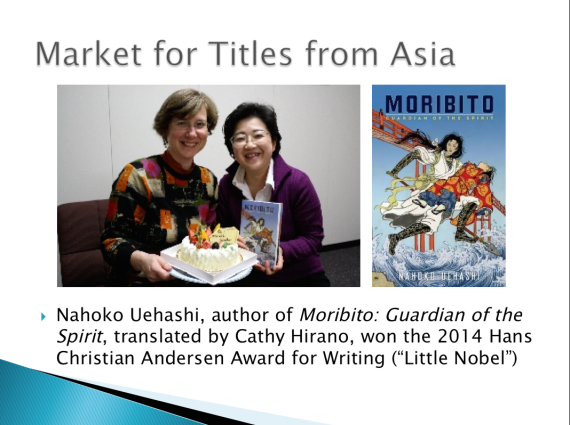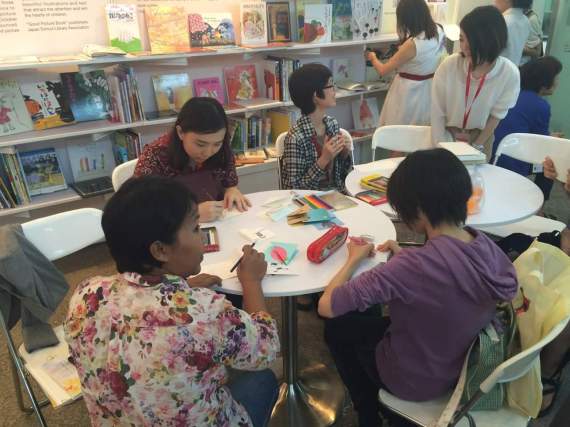By Avery Fischer Udagawa, Bangkok
Pinch me! I cannot believe that next month, I’ll be at the National Library in Singapore for Asian Festival of Children’s Content 2016, rubbing shoulders with . . . 
These are just a few speakers set to appear in the Japan: Country of Focus track at this year’s AFCC. A full list of Japan presenters is here. This dream team includes:
Akiko Beppu, editor. Ms. Beppu nurtured the Moribito fantasy novels by Nahoko Uehashi, which became bestsellers and the basis of manga, anime, radio and TV versions (the TV dramatization is airing in Japan over three years). In a show of confidence and initiative, Ms. Beppu commissioned a full English translation of the first Moribito novel. This move helped overseas publishers read the novel in its entirety and appreciate its true quality. Result? Moribito: Guardian of the Spirit and Moribito II: Guardian of the Darkness were published in English and other languages, won a Mildred L. Batchelder Award and Batchelder Honor, and paved the way for Uehashi to win the 2014 Hans Christian Andersen Award for Writing—a biennial award also dubbed the Nobel Prize for children’s literature.
Cathy Hirano, translator. Originally from Canada, Hirano has spent her adult life in Japan and become a leading translator of children’s and YA books from Japanese to English. She translated the middle grade realistic novel The Friends by Kazumi Yumoto, which won a Batchelder Award and a Boston Globe-Horn Book Award for Fiction. She translated Moribito and Moribito II, leading to Uehashi’s Andersen Award, a Batchelder, and a Batchelder Honor—becoming one of few translators to produce multiple Batchelder winners in different genres. Her first translation of the fantasy novel Dragon Sword and Wind Child by Noriko Ogiwara won so many fans that when it fell out of print in the U.S., it became a collector’s item and got republished, with a sequel. She is translator of Hanna’s Night by beloved printmaker-illustrator Komako Sakai.
 Kazuo Iwamura, author-illustrator, created the long-selling Family of Fourteen picture book series. This series—partially translated into English for the Japan market by the amazing Arthur Binard, and order-able from anywhere—portrays a clan of fourteen mice who bathe, sleep, cook, sing and play in ways quintessentially Japanese. It’s impossible to watch them savor their homemade bento lunches, doze off in their snug communal sleeping area, or view the full moon (from a special platform in a tree) without admiring Japan’s best traditions around family, nature and childhood. Mr. Iwamura’s books will make you want to move to Japan.
Kazuo Iwamura, author-illustrator, created the long-selling Family of Fourteen picture book series. This series—partially translated into English for the Japan market by the amazing Arthur Binard, and order-able from anywhere—portrays a clan of fourteen mice who bathe, sleep, cook, sing and play in ways quintessentially Japanese. It’s impossible to watch them savor their homemade bento lunches, doze off in their snug communal sleeping area, or view the full moon (from a special platform in a tree) without admiring Japan’s best traditions around family, nature and childhood. Mr. Iwamura’s books will make you want to move to Japan.
Kyoko Sakai, editor, shepherded the Family of Fourteen books and many works of kamishibai, for which her company Doshinsha is known worldwide. Yumiko Sakuma, translator, has brought famous children’s titles into Japanese, including the Rowan of Rin series from Australia and the book Of Thee I Sing by U.S. President Barack Obama. Dr. Miki Yamamoto, manga artist, has created stunning works such as How Are You? and Sunny Sunny Ann, and the wordless picture book Ribbon Around a Bomb. Satoko Yamano, singer, is well-known for performing children’s songs in Japan, as is Toshihiko Shinzawa, singer.
Naomi Kojima, illustrator, created the classic picture book Singing Shijimi Clams. Chihiro Iwasaki (1918-1974), artist, illustrated the novel Totto-chan: Little Girl at the Window, which is one of the world’s most-translated children’s titles. Iwasaki will be discussed by staff of the acclaimed Chihiro Art Museum, located in Tokyo and in Azumino, Nagano Prefecture.
Holly Thompson, Mariko Nagai, and Trevor Kew, authors who write from and about Japan in English, will speak about their vocation of writing between cultures.
Staff of the extensive International Library of Children’s Literature, part of Japan’s National Diet Library, will speak—as will representatives of Bookstart Japan, which provides picture books for newborn babies in more than half of the cities and towns in Japan.
I get to speak too, and I am quaking in my boots.
These folks have created a treasury of Japan children’s content, and helped to build the publishing world and literate society that support it. If you can be in Singapore on May 25-29, 2016, come hear this incredible dream team. Such a line-up of speakers is rare to see even in Japan!

Upper right: Logo for AFCC 2016 Japan: Country of Focus. Above: Illustration from Singing Shijimi Clams © Naomi Kojima
 By Avery Fischer Udagawa, Bangkok
By Avery Fischer Udagawa, Bangkok






 Helping out at the Japan Booth and attending some sessions on the final day of the
Helping out at the Japan Booth and attending some sessions on the final day of the 







